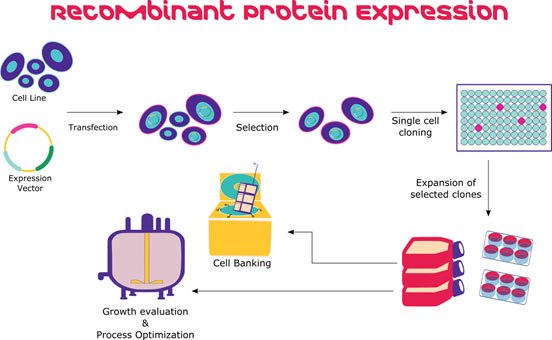Cell Lines for Recombinant Protein Expression
Recombinant protein production in mammalian and insect cell lines
Because of their protein synthesis capabilities, eukaryotic cell lines have become essential to the process of producing recombinant proteins. Their ability to aid complex post-translational modifications (glycosylation, phosphorylation), protein folding, and molecular assembly surpasses other systems. Recombinant protein production begins with expression vector engineering and transfection into the host system, which is followed by cell selection, cloning, screening, and evaluation. In order to meet quality and scalability requirements, researchers producing recombinant protein need cost-effective and efficient expression hosts

Mammalian Cells
Mammalian cells must often be used to yield recombinant proteins with the correct post-translational modifications. Recombinant proteins from mammalian cells have found use in therapeutics for diseases from diabetes to cancer, changing the healthcare landscape. This vast potential has led to the exploration of various mammalian systems to host and secrete recombinant proteins. Currently, Chinese hamster ovary (CHO) and human embryonic kidney (HEK 293) cells are preferentially used due to:
- High cell density in suspension culture and production of high protein yield
- More Successful transfection
- Survival in serum-free media
- Different strains available for targeted integration of transgenes
- Reduced risk of viral infection
Optimal mammalian cell lines are selected by considering the productivity, bioactivity, purpose, and physicochemical characteristics of the protein of interest. Our mammalian cell lines support small-scale construct screening, as well as the rapid production of protein at the milligram scale.
Insect Cells
Widely used for the production of recombinant proteins for structural studies, insect expression platforms are inexpensive, scalable, and less demanding than mammalian cells. These cells can be grown in spinner or shaker flasks and do not require a CO2-enriched atmosphere. Established insect cell lines may produce recombinant proteins with high yields and require smaller culture volumes.
Key Features of Insect Expression Platforms
- Signal peptides cleaved as in mammalian systems
- Disulfide bonds formed in endoplasmic reticulum
- Proprotein-converting enzymes available for proteolytic processing
- Membrane composition similar to mammalian systems
Animal Component Free Media
Traditional cell culture techniques require animal serum at concentrations of up to 20% of the total culture volume. Based on concerns about adventitious agents sometimes found in animal-derived serum, serum-free media has become preferred in the production of recombinant protein for therapeutic use. Our offering of mammalian cell lines includes those that can be cultured in animal component-free media.
To continue reading please sign in or create an account.
Don't Have An Account?